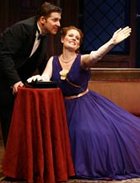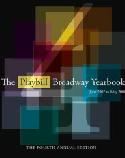SITE GUIDE
SEARCH
REVIEWS
REVIEW ARCHIVES
ADVERTISING AT CURTAINUP
FEATURES
NEWS
Etcetera and
Short Term Listings
LISTINGS
Broadway
Off-Broadway
NYC Restaurants
BOOKS and CDs
OTHER PLACES
Berkshires
London
California
New Jersey
Philadelphia
Elsewhere
QUOTES
TKTS
PLAYWRIGHTS' ALBUMS
LETTERS TO EDITOR
FILM
LINKS
MISCELLANEOUS
Free Updates
Masthead
A CurtainUp Review
The Middle Ages
|
Look. Here it all is. The weapons, the battle trophies, the sacred chronicles. Pick a book, any book. (Takes a book from the shelf, blows off the dust, reads the title). Ivanhoe, by Sir Walter Scott. That's us, in three volumes. Heavy armor, extravagant crusades, endless tournaments. And a hero in love with the wrong woman. — Barney
|

Terry Small and Marilee Talkington in The Middle Ages
(Photo: Carol Rosegg) |
The prolific Gurney, more than any other American playwright, has chronicled the lives and sensibilities of White Anglo Saxon Protestants, comically spearheading the virtues so dear to them. Though The Middle Ages is one of his lesser works, the current production, under the auspices of Theater Breaking Through Barriers, has some fine moments, and contains seeds of his later masterpiece The Dining Room.
The play is a four-hander, with patriarch Charles (George Ashiotis), his son Barney (Terry Small), his daughter-in-law Eleanor (Marilee Talkington), and her mother Myra (Melanie Boland) all holding a corner of the action in a Midwestern city. Under the firm direction of Ike Schambelan we get to freshly glimpse youth at loggerheads with tradition and the proverbial Old Guard. Gurney displays his knack for giving flesh and blood to Blue Bloods, and showing us how the small rifts between fathers and sons can elevate into seismic family tremors, and perhaps even signal political-social change.
This post-World War II story is structured as a series of flashbacks. Charles's death serves as the framing device to take us from the mid 40s to the late 70s. In fact, the play may be seen as a sort of updated prodigal son story, with Barney as the stand-in for the wayward scion of a wealthy father. He is charming, popular, daring, and infatuated with Eleanor, a local girl who decides to marry Barney's more stable brother Billy (who's off-stage for the entire play). In spite of Eleanor's rejection, Barney will always hold a secret flame for her and, impervious to everything that smacks of common sense, recklessly roams the world and, in Robin Hood fashion, blurring the moral boundaries between right and wrong. When he does l show up for some family reunions at the men's club it's always with some fresh shocking anecdote fit for The National Enquirer's front page. As for his family, Charles finds happiness in his second marriage to Myra, and Eleanor and his brother raise a growing family.
What makes the play miss the mark at some points is that the character of Barney is overdrawn, at times carrying on with excessively boisterous behavior and his zany outpourings sometimes stretch into the surreal. One might sympathize with his Navy adventures during the Korean War as well as his stint as a campus activist in California during his graduate student days. Ironically, his ultimate success as a successful porn film producer triggers a reconciliation with his family but it makes the author's effort to trumpet that the ends justify the means, come off as too pat.
The acting kudos go3w to the senior actors here. Both George Ashiotis as Charles, and Melanie Boland as Myra are superb. Their chemistry works well, and they prove to be just as convincing in their courtship as in their pragmatic marriage. Terry Small as the incorrigible Barney seems uneven in his acting. Naturally, it's tricky to play a character whose age shifts between his teens to his 40s in a blink. Small, who appears to be in his 20s, looks uncomfortable playing Barney at 16 and seemed under-rehearsed. Marilee Talkington exudes more panache as the sensible Eleanor.
Set designer Bert Scott has aptly tapped into the play's symbolic reserves with a top-drawer replica of a trophy room in a men's club, complete with towering shelves of leather-bound books, a gleaming trophy cup as well as the stuffed heads of wild animals and a game fish, and a rack of hunting guns mounted above the walls' wainscotting. Completing this is an upstage Gothic-styled window, with leaded glass, which suitably hints at the larger world outside the men's club. Everything suggests privilege, and a decided aristocratic air.
Gurney's many diehard fans as those unfamilir with his work will not want to miss this portrait of a White Anglo Saxon Protestant family and eavesdrop on a vanishing era.
|
The Middle Ages Written by A. R. Gurney Directed by Ike Schambelan Cast: Terry Small (Barney), Marilee Talkington (Eleanor), George Ashiotis (Charles), Melanie Boland (Myra). Sets: Bert Scott Costumes: Chloe Chapin Sound: Richard M. Rose Lighting: Bert Scott Hair and Wig Designer: Angelina Jerbasi Production Stage Manager: Kimothy Cruse Fight Director: J. David Brimmer Running time: One hour: 50 minutes plus a 10 minute intermission Theater Breaking Through Barriers at Kirk Theatre on Theatre Row 410 West 42nd Street 212/279-4200 From 10/22/08; opening 11/02/08; closes 11/23/08 Wednesday & Thursday @ 7pm; Friday & Saturday @ 8pm; Saturday and Sunday @ 3pm. Reviewed by Deirdre Donovan based on October 30th press performance |
|
REVIEW FEEDBACK Highlight one of the responses below and click "copy" or"CTRL+C"
Paste the highlighted text into the subject line (CTRL+ V): Feel free to add detailed comments in the body of the email. |






